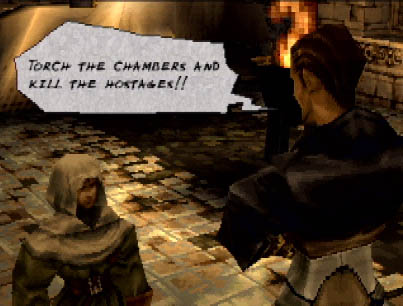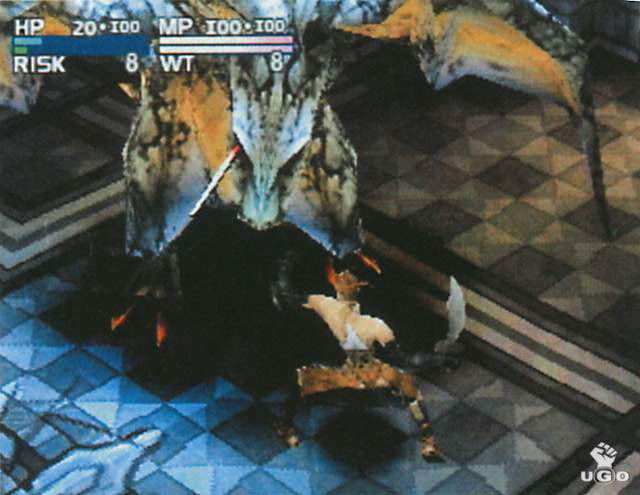 |
Vagrant Story - Review |
 |
Well...It Has a Good Story, At Least
By: Brian Rogovitz
| Review Breakdown |
| Battle System |
1 |
| Interface |
1 |
| Music/Sound |
6 |
| Originality |
8 |
| Plot |
10 |
| Localization |
10 |
| Replay Value |
3 |
| Visuals |
8 |
| Difficulty |
Hard |
| Time to Complete |
20-25 hours
|
|
| Overall |
 |
| Criteria
|
2000 was an incredibly productive year for Square, with their "Summer of Adventure" and the release of Final Fantasy IX. As a prelude to this spree of titles, Vagrant Story was unleashed upon the helpless masses. Sporting some amazing graphics and a classic medieval setting, the hype began to make its usual rounds. At the word of many glowing reviews, people everywhere bought into that hype -- and soon after regretted that purchase. Who would have thought that a game by the creator of Final Fantasy Tactics could be so...bad?
Let's start with the good points. Fitting with its title, Vagrant Story tells an absolutely amazing tale. The storyline follows Ashley Riot, a "Riskbreaker" sent to investigate some cult activities. Throughout the course of this extremely dark and mysterious game, you'll travel all over the magic-ridden town of Lea Monde, experience several sudden plot twists, and delve deep into the psychologically-distraught past of Ashley. The plot is nothing like Square has done before; despite its fantasy setting, the game is more serious than any Final Fantasy title to date. There are several scenes full of disturbingly gory events that don't feel fake or gratuitous -- everything about the story fits together perfectly.
Furthermore, the game features what might possibly be the best localization ever. Written in an almost Shakespearean tone, the language sets the perfect mood and places the events of the story in a convincingly medieval setting (so in addition to the swords and sorcery, the people even stay in character when speaking). Dialogue is completely text-driven, but it is displayed on the screen in almost comic-book text bubbles with a handwritten font that gives a sense of urgency to the story, and conveys emotions quite well.

|
| Evil plans
|
|
The music also adds to the darkness of the game, though there is very little actual music. The soundtrack is mostly ambient sounds, but what music is actually there is decent....at least it never gets boring, repetitive, and annoying. The sound effects are similarly adequate. Sword strikes sound the way they should, enemies scream when they get hurt and die, you can hear running water when next to a river or sewer. All in all, the sound is nothing spectacular, but nothing horrible, either.
Finally, there are the graphics, which are some of the finest you'll find on the original PlayStation. The character models are all nicely detailed and have enough distinguishing features to make them easily identifiable. There aren't a whole lot of different monster designs, but most are unique and also highly detailed. Boss enemies are huge, and can be extremely intimidating. All the environments are equally detailed, but here the graphical limitations of the PSX start to show. Overall, the environments are extremely bland in color and texture. Dungeon maps are blue, gray, or reddish in color, and outdoor areas are a mix of gray and green...and that's basically it. The textures all work, but are very repetitive, so rooms have to usually be distinguished by shape, and not by appearances.
Now onto the major downfall of the game: the battle system. In Vagrant Story, your party consists solely of Ashley Riot. If you've ever played Parasite Eve, you'll find some of these aspects familiar. When you have to fight an enemy, you open a sphere indicating your range of attack, which changes depending on the weapon you use. A little bit into the game, you gain the ability to "chain" attacks together in order to increase the amount of damage you do to the enemy as well as add status effects. This sounds fine so far, until you actually put it into action. Chaining is essential to beating bosses, as you will generally only take off 1-2 HP per attack. Chaining also gradually increases your attacks in a single chain, so if you begin a chain by dealing 1 HP of damage, you might find yourself taking off 20+ HP per shot fifteen or twenty hits down the line. The biggest problem with this system however, is how utterly tedious it is. If you miss even once, you have to start all over from the beginning. Enemies get far fewer attacks than you do, so you'll be spending the majority of your time setting up attacks. The enemies do, however, eventually take off a fair chunk of your health, thus making battles somewhat on the evil side of difficult.
There is a way to somewhat increase the damage you deal: the weapon modification system. In workshops scattered throughout the town, you can use items found to modify or create entirely new weapons, custom made to defeat certain types of enemies. The problem with this system is that it's overly-complex without nearly enough guidance. Sure, you have all these items that you found, but what makes a good weapon, and how do you know what you'll need in the coming areas? It is not often easy to tell, so much of the time is left to chance. You also have magic spells and special abilities available, but aside from the ones that affect your surrounding environment or healing spells, these are mostly worthless as physical attacks usually do more damage.

|
| Fighting a dragon |
|
Yet another completely unnecessary system in this game is the Risk system. Whenever you battle, a bar at the top of the screen gradually fills up. The more full it is, the more worthless as a fighter Ashley becomes, as he will miss more often and leave himself open to more attacks. When you are hit by an enemy, parts of your body become injured to the point where you lose all use of them. Take too much damage to your legs, and you can't run or jump. If your arm becomes too injured, you can't use your weapon. And so forth.
The game play outside of battle is also very tedious. The game is set up in a fairly non-linear fashion, meaning you can go from room-to-room and explore as you like...as long as you have the right keys. Much of the exploration time is spent looking for keys to open up unexplored areas, battling enemies the entire way with an occasional story sequence thrown in. This game is a dungeon-crawl in every sense of the word, and if you don't use the map and the mini-map located in the corner of the screen, it can be very easy to get lost. Sometimes you have to work through box-pushing puzzles that become increasingly difficult as the game progresses, but unlike those found in ICO, the puzzles here neither fit the general feel of the game, nor are they very fun.
If you do manage to work through the horrible battle system and lackluster exploration, the game rewards you with...more of the same. On your first run through the game, you can only explore about 80% of the town, due to a lack of a specific type of key. After you beat the game, you get this key and are able to plunge into the new areas of town to find new items, monsters, and bosses, but if you didn't enjoy exploring the first time around, going back and doing it again is pointless.

|
| Timed puzzle sequences |
|
The first time through the game usually takes roughly 20 hours, depending on how long it takes you to figure out the different systems and how much you feel like exploring. After that, subsequent playthroughs take much less time -- somewhere in the range of 5 - 10 hours. Not that there is any reason to replay the game, since you don't get any more story out of it, and the story is really the only reason to play this game. The battle system is truly one of the worst ever created, exploration is boring and confusing, and overall the frustration this game deals out will make you want to put the controller through the television.
|










